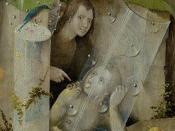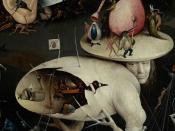Excess and Restraint refers to either the elements of design or to the conceptual content of a piece. An artwork can be excessive or restrained in the design elements or it may deal with a concept which is excessive in nature. Hieronymus Bosch and George Gittoes are both artists who deal with excessive concepts and use excessive elements of design.
Hieronymus Bosch (c.1450-1516) was one of the most intriguing artists of the late middle ages (Ref:3). Through an art rich in strange and disturbing images Bosch reflected the concerns of an age dominated by religion and death. His
mysterious paintings were complex moralistic allegories, intended to point out to men the error of their ways. Bosch's art was excessive the conceptual content, as he painted about the vices and corruption of humankind, but he also used elements of restraint to emphasise the excessive elements. Another artist who expresses through his work his concerns about social issues and the corruption of mankind is George Gittoes (1949- ).
Gittoes often uses shocking, confronting, and grotesque imagery in order to convey his messages powerfully (Ref:1). His pieces are similar to that of Bosch's art in that he portrays excessive concepts as well as using excessive elements and principles of design.
'The Garden of Earthly Delights' triptych (c.1500) by Hieronymus Bosch, is an allegory which depicts the beginning of humanity to it's downfall as a result of sin. Bosch has used the elements of design to convey his message and has created contrast between the three images. The first panel 'The Creation of Eve' depicts the presentation of Eve to Adam by Christ. The centre piece 'The Garden of Delights' is devoted to lust and the idea that it is the cause of the downfall of mankind. The right panel 'The Musician's...


